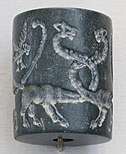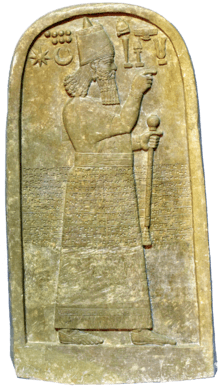List of Assyrian kings
The King of Assyria (Akkadian: šar māt Aššur[1]), called the Governor or Viceroy of Assyria (Akkadian: Išši’ak Aššur[2]) in the Early and Old periods, was the ruler of the ancient Mesopotamian kingdom of Assyria, which existed from approximately the 26th century BC to the 7th century BC. All modern lists of Assyrian kings generally follow the Assyrian King List, a list kept and developed by the ancient Assyrians themselves over the course of several centuries. Though some parts of the list are probably fictional, the list accords well with Hittite, Babylonian and ancient Egyptian king lists and with the archaeological record, and is generally considered reliable for the age.
| King of Assyria | |
|---|---|
.jpg) | |
| Details | |
| First monarch | Tudiya (traditional) Shalim-ahum (earliest contemporarily attested) |
| Last monarch | Ashur-uballit II |
| Formation | c. 2450 BC |
| Abolition | 609 BC |
| Appointer | Divine right, hereditary |
The ancient Assyrians did not believe that their king was divine himself, but saw their ruler as the vicar of their principal deity, Ashur, and as his chief representative on Earth. In their worldview, Assyria represented a place of order while lands not governed by the Assyrian king (and by extension, the god Ashur) were seen as places of chaos and disorder. As such it was seen as the king's duty to expand the borders of Assyria and bring order and civilization to lands perceived as uncivilized.
Originally vassals of more powerful empires, the early Assyrian kings used the title governor or viceroy (Išši’ak), which was retained as the ruling title after Assyria gained independence due to the title of king (šar) being applied to the god Ashur. Later Assyrian kings, beginning with Ashur-uballit I (14th century BC) adopted the title šar māt Aššur as their empire expanded and later also adopted more boastful titles such as "king of Sumer and Akkad", "king of the Universe" and "king of the Four Corners of the World", often to assert their control over all of Mesopotamia.
The line of Assyrian kings ended with the defeat of Assyria's final king Ashur-uballit II by the Neo-Babylonian Empire and the Median Empire in 609 BC, after which Assyria disappeared as an independent political unit, never to rise again. The Assyrian people survived and remain as an ethnic, linguistic, religious (Christians since the 1st–3rd centuries AD) and cultural minority in the Assyrian homeland and elsewhere to this day.
Sources
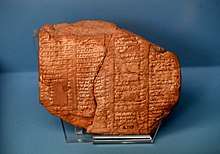
Incomplete king-lists have been recovered from all three of the major ancient Assyrian capitals (Aššur, Dur-Šarukkin and Nineveh). The three lists are largely consistent with each other, all originally copies of a single original list, and are based on the yearly appointments of limmu-officials (the eponymous officials for each year, appointed by the king to preside over the celebration of the New Year festival). Because of the consistency between the list and the method through which it was created, modern scholars usually accept the regnal years mentioned as more or less correct. There are some differences between the copies of the list, notably in that they offer somewhat diverging regnal years before the reign of king Ashur-dan I of the Middle Assyrian Empire (reign beginning in 1178 BC). After 1178 BC, the lists are identical in their contents.[3]
The king-lists mostly accord well with Hittite, Babylonian and ancient Egyptian king lists and with the archaeological record, and are generally considered reliable for the age.[4] It is however clear that parts of the list are fictional, as some known kings are not found on the list and other listed kings are not independently verified.[5] Originally it was assumed that the list was first written in the time of Shamshi-Adad I circa 1800 BC but it now is considered to date from much later, probably from the time of Ashurnasirpal I (1050–1031 BC).[6] The oldest of the surviving king-lists, List A (8th century BC) stops at Tiglath-Pileser II (c. 967–935 BC) and the youngest, List C, stops at Shalmaneser V (727–722 BC).[7]
One problem that arises with the Assyrian King List is that the creation of the list may have been more motivated by political interest than actual chronological and historical accuracy. In times of civil strife and confusion, the list still adheres to a single royal line of descent, probably ignoring rival claimants to the throne.[8] Additionally, there are some known inconsistencies between the list and actual inscriptions by Assyrian kings, often regarding dynastic relationships. For instance, Ashur-nirari II is stated by the list to be the son of his predecessor Enlil-Nasir II, but from inscriptions it is known that he was actually the son of Ashur-rabi I and brother of Enlil-Nasir.[9]
Titles
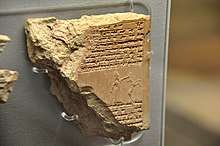
Assyrian royal titles typically followed trends that had begun under the Akkadian Empire (c. 2334–2154 BC), the Mesopotamian civilization that preceded the later kingdoms of Assyria and Babylon. When the Mesopotamian central government under the Third Dynasty of Ur (c. 2112–2004 BC) collapsed and polities that had once been vassals to Ur became independent, many of the new sovereign rulers refrained from taking the title of king (šar), instead applying that title to their principal deities (in the case of Assyria, Ashur). For this reason, most of the Assyrian kings of the Old Assyrian period (c. 2025–1378 BC) used the title Išši’ak Aššur, translating to "governor of Assyria".[10][2]
In contrast to the titles employed by the Babylonian kings in the south, which typically focused on the protective role and the piety of the king, Assyrian royal inscriptions tend to glorify the strength and power of the king.[11] Assyrian titularies usually also often emphasize the royal genaeology of the king, something Babylonian titularies do not, and also drive home the king's moral and physical qualities while downplaying his role in the judicial system.[12] Assyrian epithets about royal lineage vary in how far they stretch back, most often simply discussing lineage in terms of "son of ..." or "brother of ...". Some cases display lineage stretching back much further, Shamash-shuma-ukin (r. 667–648 BC) describes himself as a "descendant of Sargon II", his great-grandfather. More extremely, Esarhaddon (r. 681–669 BC) calls himself a "descendant of the eternal seed of Bel-bani", a king who would have lived more than a thousand years before him.[13]
Assyrian royal titularies were often changed depending on where the titles were to be displayed, the titles of the same Assyrian king would have been different in their home country of Assyria and in conquered regions. Those Neo-Assyrian kings who controlled the city of Babylon used a "hybrid" titulary of sorts in the south, combining aspects of the Assyrian and Babylonian tradition, similar to how the traditional Babylonian deities were promoted in the south alongside the Assyrian main deity of Ashur.[12] The assumption of many traditional southern titles, including the ancient "king of Sumer and Akkad" and the boastful "king of the Universe" and "king of the Four Corners of the World", by the Assyrian kings served to legitimize their rule and assert their control over Babylon and lower Mesopotamia.[14] Epithets like "chosen by the god Marduk and the goddess Sarpanit" and "favourite of the god Ashur and the goddess Mullissu", both assumed by Esarhaddon, illustrate that he was both Assyrian (Ashur and Mullissu, the main pair of Assyrian deities) and a legitimate ruler over Babylon (Marduk and Sarpanit, the main pair of Babylonian deities).[15]
To examplify an Assyrian royal title from the time Assyria ruled all of Mesopotamia, the titulature preserved in one of Esarhaddon's inscriptions read as follows[16]:
The great king, the mighty king, king of the Universe, king of Assyria, viceroy of Babylon, king of Sumer and Akkad, son of Sennacherib, the great king, the mighty king, king of Assyria, grandson of Sargon, the great king, the mighty king, king of Assyria; who under the protection of Assur, Sin, Shamash, Nabu, Marduk, Ishtar of Nineveh, Ishtar of Arbela, the great gods, his lords, made his way from the rising to the setting sun, having no rival.
Role of the Assyrian king
%2C_c._645-635_BC%2C_British_Museum_(16722368932).jpg)
Ancient Assyria was an absolute monarchy, with the king believed to be appointed directly through divine right by the chief deity, Ashur.[17] The Assyrians believed that the king was the link between the gods and the earthly realm. As such, it was the king's primary duty to discover the will of the gods and enact this, often through the construction of temples or waging war. To aid the king with this duty, there was a number of priests at the royal court trained in reading and interpreting signs from the gods.[18]
The heartland of the Assyrian realm, Assyria itself, was thought to represent a serene and perfect place of order whilst the lands governed by foreign powers were perceived as infested with disorder and chaos.[17] The peoples of these "outer" lands were seen as uncivilized, strange and as speaking strange languages.[19] Because the king was the earthly link to the gods, it was his duty to spread order throughout the world through the military conquest of these strange and chaotic countries.[17] As such, imperial expansion was not just expansion for expansion's sake but was also seen as a process of bringing divine order and destroying chaos to create civilization.[19]
There exists several ancient inscriptions in which the god Ashur explicitly orders kings to extend the borders of Assyria. A text from the reign of Tukulti-Ninurta I (r. c. 1233–1197 BC) states that the king received a royal scepter and was commanded to "broaden the land of Ashur". A similar inscription from the reign of Ashurbanipal (r. 668–631 BC) commands the king to "extend the land at his feet".[19]
The king was also tasked with protecting his own people, often being referred to as a "shepherd". This protection included defending against external enemies and defending citizens from dangerous wild animals. To the Assyrians, the most dangerous animal of all was the lion, used (similarly to foreign powers) as an example of chaos and disorder due to their aggressive nature. To prove themselves worthy of rule and illustrate that they were competent protectors, Assyrian kings engaged in ritual lion hunts. Lion-hunting was reserved for Assyrian royalty and was a public event, staged at parks in or near the Assyrian cities.[17] In some cases, the hunt even took place with captive lions in an arena.[20]
Legitimacy
As opposed to some other ancient monarchies, such as ancient Egypt, the Assyrian king was not believed to be divine himself, but was seen as divinely chosen and uniquely qualified for the royal duties. Most kings stressed their legitimacy through their familial connections to previous kings; a king was legitimate through his relation to the previous line of great kings who had been chosen by Ashur. Usurpers who were unrelated to previous kings usually either simply lied about being the son of some previous monarch or claimed that they had been divinely appointed directly by Ashur.[19]
Two prominent examples of such usurpers are the kings Tiglath-Pileser III (r. 745–727 BC) and Sargon II (r. 722–705 BC). The inscriptions of these kings completely lack any familial references to previous kings, instead stressing that Ashur himself had appointed them directly with phrases such as "Ashur called my name", "Ashur placed me on the throne" and "Ashur placed his merciless weapon in my hand".[19]
List of kings
Early Assyrian kings (2450–2025 BC)
As in the Sumerian king list, it is possible that some of the rulers listed below were contemporaries rather than predecessors and successors of each other.[21] No dates are provided by the Assyrian King List for kings preceding the Old Assyrian Empire, making the lengths of the reigns of these kings (many of which may not have existed at all) unknown.[3]
"Kings who lived in tents"
The intention of the author of the list, describing the first (probably all fictional, note the rhyming names) seventeen kings as "kings who lived in tents", was probably to indicate them as nomadic kings of the Assyrians.[3] Considering them "living in tents", these rulers (if they were real in the first place) probably did not govern the actual city of Aššur itself.[21] It is possible that the conclusion of this section on the king list would have indicated an end of the nomadic period of Assyrian history and the foundation of Aššur.[22]
| No. | King | Succession | Notes | Ref |
|---|---|---|---|---|
| 1 | Tudiya Tūdīja |
Unknown | [3][23] | |
| 2 | Adamu Adāmu |
Unknown | [3][23] | |
| 3 | Yangi Jangi |
Unknown | [3][23] | |
| 4 | Suhlamu Suḫlāmu |
Unknown | [3][23] | |
| 5 | Harharu Ḫarḫaru |
Unknown | [3][23] | |
| 6 | Mandaru Mandāru |
Unknown | [3][23] | |
| 7 | Imsu Imṣu |
Unknown | [3][23] | |
| 8 | Harsu Ḫarṣu |
Unknown | [3][23] | |
| 9 | Didanu Didānu |
Unknown | [3][23] | |
| 10 | Hana Ḫanû |
Unknown | [3][23] | |
| 11 | Zuabu Zuabu |
Unknown | [3][23] | |
| 12 | Nuabu Nuabu |
Unknown | [3][23] | |
| 13 | Abazu Abāzu |
Unknown | [3][23] | |
| 14 | Belu Bēlû |
Unknown | [3][23] | |
| 15 | Azarah Azaraḫ |
Unknown | [3][23] | |
| 16 | Ushpia Ušpia |
Unknown | Possibly the founder of the temple dedicated to Ashur in Aššur. | [3][23][22] |
| 17 | Apiashal Apiašal |
Son of Ushpia | [3][23] |
"Kings who were ancestors"
The meaning of "kings who were ancestors" is unclear, this section is also the only section of the Assyrian king list to be written in reverted order for reasons unknown. The list mentions "ten kings who were ancestors" but includes the final king of the "kings who lived in tents", Apiashal, as one of them, possibly an error.[3]
| No. | King | Succession | Notes | Ref |
|---|---|---|---|---|
| 17 | Apiashal Apiašal |
Son of Ushpia | Also appeared in the preceding section. | [3][23] |
| 18 | Hale Ḫalê |
Son of Apiashal | [3][23] | |
| 19 | Samani Samānu |
Son of Hale | [3][23] | |
| 20 | Hayani Ḫajjāni |
Son of Samani | [3][23] | |
| 21 | Ilu-Mer Ilī-Mēr |
Son of Hayani | [3][23] | |
| 22 | Yakmesi Jakmesi |
Son of Ilu-Mer | [3][23] | |
| 23 | Yakmeni Jakmeni |
Son of Yakmesi | [3][23] | |
| 24 | Yazkur-el Jazkur-il |
Son of Yakmeni | [3][23] | |
| 25 | Ila-kabkabu Ila-kabkabū |
Son of Yazkur-el | [3][23] | |
| 26 | Aminu Aminu |
Son of Ila-kabkabu | [3][23] |
"Kings named on bricks whose eponyms are unknown"
The kings listed in this section would probably have been early rulers of Aššur.[7]
| No. | King | Succession | Notes | Ref |
|---|---|---|---|---|
| 27 | Sulili Sulili |
Son of Aminu | [3][23] | |
| 28 | Kikkia Kīkkia |
Unknown | Mentioned by later kings as having restored the inner city wall of Aššur. | [3][23][24] |
| 29 | Akiya Akīa |
Unknown | [3][23] |
Old Assyrian kings (2025–1380 BC)
The Old Assyrian kings can based on their relationships be divided into four groupings; the dynasty of Puzur-Ashur, followed by the dynasty of Shamshi-Adad (also known as the Amorite dynasty), followed by a period of Babylonian domination of Assyria, finally followed by the Adaside dynasty.[25] Dating the reigns of the Old Assyrian kings is not uncontroversial, the dates used here are the conventional ones.[26][27]
Dynasty of Puzur-Ashur (2025–1809 BC)
The period beginning with Puzur-Ashur I's reign is sometimes referred to as the dynasty of Puzur-Ashur.[28] Puzur-Ashur's line saw the beginning of true Akkadian names in the Assyrian royal line as opposed to earlier names which may have corresponded closer to Hurrian names.[21] The three first kings listed here are part of the earlier "kings named on bricks whose eponyms are unknown" section of the king list,[7] but have been included here due to their dynastic relationship.
| No. | King | Reign[26] | Succession | Notes | Ref |
|---|---|---|---|---|---|
| 30 | Puzur-Ashur I Puzur-Aššur |
fl. c. 2000 BC | Unknown | Mentioned by later kings as having restored the inner city wall of Aššur. | [3][23][28][29] |
| 31 | Shalim-ahum Šallim-aḫḫe |
fl. c. 1900 BC | Son of Puzur-Ashur I | The earliest Assyrian ruler to be attested in a contemporary inscription. | [3][23][30] |
| 32 | Ilu-shuma Ilu-šūma |
c. 1927 BC — c. 1906 BC (21 years) |
Son of Shalim-ahum | Although listed as one of the kings whose reigns were unknown, later inscriptions indicate that Ilu-shuma would have ruled for 21 years and preceded Tukulti-Ninurta I by 720 years. | [3][23][30][31] |
| 33 | Erishum I Erišum |
c. 1906 BC — c. 1867 BC (38 years) |
Son of Ilu-shuma | Possibly the constructor of the temple of Ashur, given a reign of 30 or 40 years depending on the version of the king list. | [32] |
| 34 | Ikunum Ikūnum |
c. 1867 BC — c. 1860 BC (7 years) |
Brother of Erishum I, son of Ilu-shuma | Strengthened Aššur and maintained commercial colonies in Asia Minor. | [32][33][34] |
| 35 | Sargon I Šarru-ukīn |
c. 1860 BC — c.1850 BC (10 years) |
Son of Ikunum | Known to have refortified Aššur. Possibly named after the Akkadian king Sargon of Akkad. | [32][35][33] |
| 36 | Puzur-Ashur II Puzur-Aššur |
c. 1850 BC — c.1830 BC (20 years) |
Son of Sargon I | Due to the long reign of his predecessor, Puzur-Ashur II came to throne relatively late in life. | [32][33] |
| 37 | Naram-Sin Narām Sîn |
c. 1830 BC — c.1815 BC (15 years) |
Son of Puzur-Ashur II | Naram-Sin and his son Erishum II allegedly had a combined reign length of 64 years. Possibly named after the Akkadian king Naram-Sin of Akkad. | [32][33] |
| 38 | Erishum II Erišum |
c. 1815 BC — c.1809 BC (6 years) |
Son of Naram-Sin | Last king of the line of Puzur-Ashur, deposed by the Amorite Shamshi-Adad I. | [32][33] |
Dynasty of Shamshi-Adad (1809–1706 BC)
Also referred to as the period of Amorite domination over Assyria.[25]
| No. | King | Reign[26] | Succession | Notes | Ref |
|---|---|---|---|---|---|
| 39 | Shamshi-Adad I Šam-ši-Adad |
c. 1809 BC — c.1781 BC (33 years) |
Usurper, possibly related to earlier kings such as Sulili | Originally the king of Terqa, Shamshi-Adad became king of Assyria after deposing Erishum II. As king, Shamshi-Adad conquered significant territories and was the first Assyrian king to adopt the title of "king of the Universe". | [23] |
| 40 | Ishme-Dagan I Išme-Dagān |
c. 1780 BC — c.1741 BC (39 years) |
Son of Shamshi-Adad I | Accorded with a reign of forty years by the king list, archaeological findings and limmu inscriptions instead suggest a reign of only eleven years. | [23] |
| 41 | Mut-Ashkur Mut-Aškur |
c. 1730 BC — c.1720 BC (10 years) |
Son of Ishme-Dagan I | Married to the daughter of the Hurrian king Zaziya. | [36] |
| 42 | Rimush Rimuš |
c. 1720 BC — c.1710 BC (10 years) |
Descendant of Shamshi-Adad I, exact relationship unknown | Probably named after the Akkadian king Rimush. | [37] |
| 43 | Asinum Asīnum |
c. 1710 BC — c.1706 BC (4 years) |
Grandson of Shamshi-Adad I | Deposed and driven out by the vice-regent Puzur-Sin on account of his Amorite ancestry, replaced with Ashur-dugul as king. | [38] |
Babylonian domination of Assyria (1706–1700 BC)
This period is referred to as one of "seven usurpers" in the Assyrian King List.[3] Seven competing claimants reigned for a total of just six years.[39]
| No. | King | Reign | Succession | Notes | Ref |
|---|---|---|---|---|---|
| 44 | Ashur-dugul Aššur-dugul |
c. 1706 BC — c.1700 BC (6 years) |
Usurper, unrelated to previous kings | Six competing claimants claimed to be kings during Ashur-dugul's reign. | [3][39] |
| 45 | Ashur-apla-idi Aššur-apla-iddina |
Unknown | Usurper, unrelated to previous kings | [3][39] | |
| 46 | Nasir-Sin Nāsir Sîn |
Unknown | Usurper, unrelated to previous kings | [3][39] | |
| 47 | Sin-namir Sîn-nāmir |
Unknown | Usurper, unrelated to previous kings | [3][39] | |
| 48 | Ipqi-Ishtar Ipqi-Ištar |
Unknown | Usurper, unrelated to previous kings | [3][39] | |
| 49 | Adad-salulu Adad-salulu |
Unknown | Usurper, unrelated to previous kings | [3][39] | |
| 50 | Adasi Adasi |
Unknown | Usurper, unrelated to previous kings | Credited with freeing Assyria from Amorite and Babylonian influence. | [40] |
Adaside dynasty (1700–745 BC)
| No. | King | Reign[26][27] | Succession | Notes | Ref |
|---|---|---|---|---|---|
| 51 | Bel-bani Bēlu-bāni |
c. 1700 BC — c.1691 BC (8 years) |
Son of Adasi | Founder of the Adaside dynasty, which would endure for centuries. As its founder and their ancestors, Bel-bani attained a semi-mythical status for later kings. | [41] |
| 52 | Libaya Libaia |
c. 1690 BC — c.1674 BC (17 years) |
Son or brother of Bel-bani | Assyria appears to have been a relatively peaceful, secure and stable nation during Libaya's reign. | [40][41] |
| 53 | Sharma-Adad I Šarma-Adad |
c. 1673 BC — c.1662 BC (12 years) |
Son of Libaya or brother of Bel-bani | [3] | |
| 54 | Iptar-Sin Ib-Tar-Sîn |
c. 1662 BC — c.1650 BC (12 years) |
Son of Sharma-Adad I or brother of Bel-bani | [3] | |
| 55 | Bazaya Bāzāiu |
c. 1649 BC — c.1622 BC (28 years) |
Son or great-uncle of Iptar-Sin | [3][42] | |
| 56 | Lullaya Lulāiu |
c. 1621 BC — c.1618 BC (6 years) |
Usurper, unrelated to the Adaside dynasty | Reigned during a quiet and uneventful period of Assyrian history. | [3][43] |
| 57 | Shu-Ninua Šu-Ninua |
c. 1615 BC — c.1602 BC (14 years) |
Son of Bazaya | [3] | |
| 58 | Sharma-Adad II Šarma-Adad |
c. 1601 BC — c.1598 BC (3 years) |
Son of Shu-Ninua | [3] | |
| 59 | Erishum III Erišum |
c. 1598 BC — c.1586 BC (13 years) |
Son of Sharma-Adad II | [3] | |
| 60 | Shamshi-Adad II Šam-ši-Adad |
c. 1567 BC — c.1561 BC (6 years) |
Son of Erishum III | [3] | |
| 61 | Ishme-Dagan II Išme-Dagān |
c. 1561 BC — c.1545 BC (16 years) |
Son of Shamshi-Adad II | [3] | |
| 62 | Shamshi-Adad III Šam-ši-Adad |
c. 1545 BC — c.1529 BC (16 years) |
Nephew of Sharma-Adad II | [3] | |
| 63 | Ashur-nirari I Aššur-nārāri |
c. 1529 BC — c.1503 BC (26 years) |
Son of Ishme-Dagan II | [3] | |
| 64 | Puzur-Ashur III Puzur-Aššur |
c. 1503 BC — c.1479 BC (24 years) |
Son of Ashur-nirari I | [3] | |
| 65 | Enlil-nasir I Enlīl-nāsir |
c. 1479 BC — c.1466 BC (13 years) |
Son of Puzur-Ashur III | [3] | |
| 66 | Nur-ili Nur-ili |
c. 1466 BC — c.1454 BC (12 years) |
Son of Enlil-nasir I | [3] | |
| 67 | Ashur-shaduni Aššur-šaddûni |
c.1454 BC (1 month) |
Son of Nur-ili | Deposed by Ashur-rabi I, his successor to the throne. | [3] |
| 68 | Ashur-rabi I Aššur-rabi |
c. 1453 BC — c.1435 BC (18 years) |
Usurper, son of Enlil-nasir I, uncle of Ashur-shaduni | [3] | |
| 69 | Ashur-nadin-ahhe I Aššur-nādin-ahhē |
c. 1435 BC — c.1420 BC (15 years) |
Son of Ashur-rabi I | During the reign of Ashur-nadin-ahhe I, Assyria became a sporadic vassal of Mitanni. He was eventually overthrown by his brother Enlil-nasir II. | [3][44] |
| 70 | Enlil-nasir II Enlīl-nāsir |
c. 1420 BC — c.1415 BC (5 years) |
Usurper, brother of Ashur-nadin-ahhe I, son of Ashur-rabi I | [3] | |
| 71 | Ashur-nirari II Aššur-nārāri |
c. 1414 BC — c.1408 BC (6 years) |
Brother of Enlil-nasir II, son of Ashur-rabi I | Erroneously stated by the Assyrian King List to be the son of Enlil-nasir II, his own inscriptions put him as a son of Ashur-rabi I. | [3][9] |
| 72 | Ashur-bel-nisheshu Aššūr-bēl-nīšēšu |
c. 1407 BC — c.1399 BC (8 years) |
Son of Ashur-nirari II | [3] | |
| 73 | Ashur-rim-nisheshu Aššūr-rā’im-nīšēšu |
c. 1398 BC — c.1391 BC (7 years) |
Brother of Ashur-bel-nisheshu, son of Ashur-nirari II | Known to have reconstructed the inner city wall of Aššur. | [3] |
| 74 | Ashur-nadin-ahhe II Aššur-nādin-ahhē |
c. 1391 BC — c.1380 BC (12 years) |
Son of Ashur-rim-nisheshu | Considered to be the final king of the Old Assyrian period. | [3] |
Middle Assyrian kings (1380–912 BC)
The dates up to Ninurta-apal-Ekur (c. 1182–1180 BC) are subject to debate, as some of the regnal lengths vary over the different versions of the King List. The dates given below (and above from Enlil-nasir II) are based on Assyrian King Lists B and C, which give only three years to Ashur-nadin-apli, and the same to Ninurta-apal-Ekur. (Assyrian King List A gives four years to Ashur-nadin-apli and 13 years to Ninurta-apal-Ekur.[45])
Dates from 1179 to 912 BC, although less secure than dates from 911 BC onwards, are not subject to the chronology debate.[46]
| No. | Image | King | Reign[27] | Succession | Notes | Ref |
|---|---|---|---|---|---|---|
| 75 | Eriba-Adad I Erība-Adad |
c. 1380 BC — c.1353 BC (27 years) |
Brother of Ashur-nadin-ahhe II, son of Ashur-rim-nisheshu | During Eriba-Adad I's reign, Assyria finally broke free of the Mitanni Empire's control, signalling the start of the Middle Assyrian Empire. | [3][47][48][49] | |
| 76 | Ashur-uballit I Aššur-uballiṭ |
c. 1353 BC — c.1318 BC (35 years) |
Son of Eriba-Adad I | Under Ashur-uballit I, Assyria began to be transformed into a true empire. He successfully conquered the Mitanni, former overlords over the Assyrians, and led a successful campaign against Babylon. | [3][47][48][49] | |
| 77 | Enlil-nirari Enlīl-nārāri |
c. 1317 BC — c.1308 BC (10 years) |
Son of Ashur-uballit I | Enlil-nirari married his sister Muballiṭat-Šērūa to the Kassite Babylonian king Burna-Buriaš II, leading to his nephews subsequently ascending to the Babylonian throne. | [3][47][48][49] | |
| 78 | Arik-den-ili Arīk-den-ili |
c. 1307 BC — c.1296 BC (12 years) |
Son of Enlil-nirari | Arik-den-ili began the Assyrian royal traditions of annual military campaigns. He undertook many himself, notably warring far to both the west and east of Aššur. | [3][47][48][49] | |
| 79 | Adad-nirari I Adad-nārārī |
c. 1295 BC — c.1264 BC (31 years) |
Son of Arik-den-ili | The earliest Assyrian king whose annals survive in any detail, Adad-nārārī I achieved major military victories that further strengthened Assyria. He called himself the "pacifier of all enemies above and below". | [3][47][48][49] | |
| 80 | 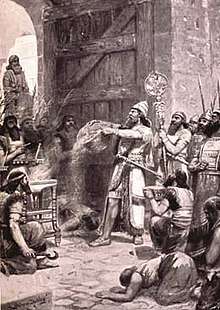 |
Shalmaneser I Šulmanu-ašaridu |
c. 1263 BC — c.1234 BC (30 years) |
Son of Adad-nirari I | One of the first Assyrian kings who was known to deport his defeated enemies to various lands rather than simply slaughtering them all. Noteworthy for completely conquering and incorporating the Mitanni kingdom into Assyria. | [3][47][48][49] |
| 81 | 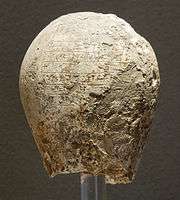 |
Tukulti-Ninurta I Tukultī-Ninurta |
c. 1233 BC — c.1197 BC (36 years) |
Son of Shalmaneser I | In the first half of his reign, Tukulti-Ninurta defeated the Hittites and incorporated some of their territory in Asia Minor and the Levant. Assyrian control was retained over Urartu and Tukulti-Ninurta's victory over Babylon and his conquest of this rival kingdom ensured full Assyrian supremacy over Mesopotamia. He was the first ruler in history to call himself "king of kings". | [3][47][48][49] |
| 82 | Ashur-nadin-apli Aššūr-nādin-apli |
c. 1197 BC — c.1194 BC (4 years) |
Usurper, son of Tukulti-Ninurta I | Deposed his father and took the throne for himself, ruling for just four years. Murdered, possibly because of him overthrowing his father. | [3][47][48][49] | |
| 83 | Ashur-nirari III Aššur-nārāri |
c. 1193 BC — c.1188 BC (6 years) |
Son or nephew of Ashur-nadin-apli | Possibly quite young when ascending to the throne, as his grand vizier Ilī-padâ was very prominent during his reign. Violently swept aside by his successor. | [3][47][48][49] | |
| 84 | Enlil-kudurri-usur Enlilbe-kudúr-uṣur |
c. 1187 BC — c.1183 BC (5 years) |
Usurper, son of Tukulti-Ninurta I | Seized the throne from the young Ashur-nirari III, deposed himself after a brief reign of five years. | [3][47][48][49] | |
| 85 | Ninurta-apal-Ekur Ninurta-apal-ekur |
c. 1182 BC — 1180 BC (3 years) |
Usurper, descendant of Eriba-Adad I | Son of the grand vizier Ilī-padâ and a descendant of Eriba-Adad I, seized the throne by force after the Babylonians defeated Enlil-kudurri-usur. | [3][47][48][49] | |
| 86 | Ashur-dan I Aššur-dān |
1179 BC–1133 BC (47 years) |
Son of Ashur-nadin-apli | Beginning with Ashur-dan I's reign, dates are consistent and uncontroversial. Led successful campaigns and raids against the Suhu and the Babylonians. | [3][47][48][49] | |
| 87 | Ninurta-tukulti-Ashur Ninurta-tukultī-Aššur |
1133 BC (less than a year) |
Son of Ashur-dan I | Deposed and exiled from Assyria by his brother Mutakkil-nusku. Took refuge in the city of Sišil at the Babylonian border. | [3][47][48][49] | |
| 88 | Mutakkil-nusku Mutakkil-nusku |
1133 BC (less than a year) |
Usurper, brother of Ninurta-tukulti-Ashur, son of Ashur-dan I | Deposed and exiled his brother Ninurta-tukulti-Ashur, later engaged him in battle at Sišil, after which both brothers disappear from history, both of them possibly falling in the battle. | [3][47][48][49] | |
| 89 | Ashur-resh-ishi I Aššur-rēša-iši |
1133 BC–1115 BC (18 years) |
Son of Mutakkil-nusku | Determined to restore the glory of Assyria, Ashur-resh-ishi I titled himself as mutēr gimilli māt Aššur, the “avenger of Assyria". Led campaigns beyond the Zagros Mountains and inflicted defeats on Babylon. | [3][47][48][49] | |
| 90 | 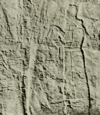 |
Tiglath-Pileser I Tukultī-apil-Ešarra |
1115 BC–1076 BC (40 years) |
Son of Ashur-resh-ishi I | One of the greatest Assyrian conquerors, Tiglath-Pileser I is known for his wide-ranging military campaigns, his enthusiasm for building projects, and his interest in cuneiform tablet collections. Under Tiglath-Pileser I, Assyria became the leading power in the Middle East, a position it would retain for the next five centuries or so. | [3][47][48][49] |
| 91 | Asharid-apal-Ekur Ašarēd-apil-Ekur |
1076 BC–1074 BC (2 years) |
Son of Tiglath-Pileser I | The end of Tiglath-Pileser I's lengthy reign saw turmoil engulf Assyria, his oldest son only reigning for two years. | [3][47][48][49] | |
| 92 | Ashur-bel-kala Aššūr-bēl-kala |
1074 BC–1056 BC (18 years) |
Brother of Asharid-apal-Ekur, son of Tiglath-Pileser I | Ashur-bel-kala's chaotic reign saw the collapse of the Middle Assyrian Empire as hordes of Arameans invaded the western borders. Also remembered for his impressive zoological collection. | [3][47][48][49] | |
| 93 | Eriba-Adad II Erība-Adad |
1056 BC–1054 BC (2 years) |
Son of Ashur-bel-kala | Claimed to have gone on wide-ranging military campaigns similar to those of Tiglath-Pileser I. Deposed by his uncle Shamshi-Adad after only two years on the throne. | [3][47][48][49] | |
| 94 | Shamshi-Adad IV Šam-ši-Adad |
1054 BC–1050 BC (4 years) |
Usurper, uncle of Eriba-Adad II, son of Tiglath-Pileser I | Probably fairly elderly when he seized the throne after having lived in exile in Babylon. | [3][47][48][49] | |
| 95 | Ashurnasirpal I Aššur-nāṣir-apli |
1049 BC–1031 BC (19 years) |
Son of Shamshi-Adad IV | Ruled during a troubled period of Assyrian history, marked by famine and war with nomads from the deserts to the west. | [3][47][48][49] | |
| 96 | 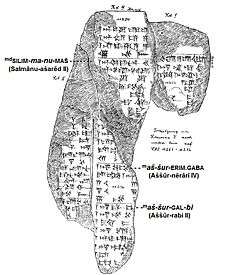 |
Shalmaneser II Šulmanu-ašaridu |
1031 BC–1019 BC (12 years) |
Son of Ashurnasirpal I | [3][47][48][49] | |
| 97 |  |
Ashur-nirari IV Aššur-nārāri |
1019 BC–1013 BC (6 years) |
Son of Shalmaneser II | The short six-year reign of Ashur-nirari IV was marked by confusion and a war against Babylon. | [3][47][48][49] |
| 98 | Ashur-rabi II Aššur-rabi |
1013 BC–972 BC (41 years) |
Son of Ashurnasirpal I | Might possibly have deposed his nephew and predecessor. The reign of Ashur-rabi II, one of the longest of any Assyrian king, was marked by decline and military setbacks. | [3][47][48][49] | |
| 99 | Ashur-resh-ishi II Aššur-rēša-iši |
972 BC–967 BC (5 years) |
Son of Ashur-rabi II | The poorly attested and short reign of Ashur-resh-ishi II is often overshadowed by the long reigns of his predecessor and successor. | [3][47][48][49] | |
| 100 | Tiglath-Pileser II Tukultī-apil-Ešarra |
967 BC–935 BC (32 years) |
Son of Ashur-resh-ishi II | Despite its length, little is known of the reign of Tiglath-Pileser II. | [3][47][48][49] | |
| 101 | Ashur-dan II Aššur-dān |
935 BC–912 BC (22 years) |
Son of Tiglath-Pileser II | Ashur-dan II recaptured previously held Assyrian territory and restored Assyria to its natural borders, from Tur Abdin (southeast Turkey) to the foothills beyond Arbel (Iraq). His military and economic expansions benefited later kings and enabled the rise of the Neo-Assyrian Empire. | [3][47][48][49] |
Neo-Assyrian kings (912–609 BC)
| No. | Image | King | Reign[27] | Succession | Notes | Ref |
|---|---|---|---|---|---|---|
| 102 | Adad-nirari II Adad-nārārī |
912 BC–891 BC (21 years) |
Son of Ashur-dan II | Succeeding his father after a minor dynastic struggle, Adad-nirari II subjugated areas previously under only nominal Assyrian vassalage and finally defeated the Arameans. He successfully defeated both the Hittites and the Babylonians in a series of battles. | [3][50][51] | |
| 103 | Tukulti-Ninurta II Tukultī-Ninurta |
891 BC–884 BC (8 years) |
Son of Adad-nirari II | Tukulti-Ninurta II consolidated the gains made by his father over the Hittites, Babylonians and Arameans, and successfully campaigned in the Zagros Mountains. | [3][50][51] | |
| 104 | 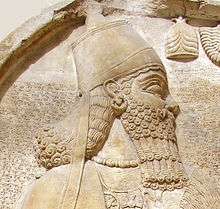 |
Ashurnasirpal II Aššur-nāṣir-apli |
884 BC–859 BC (26 years) |
Son of Tukulti-Ninurta II | Ashurnasirpal II led great conquests throughout the Middle East, reaching the Mediterranean and subjugating Babylon in the south. He is famous for the brutal inscriptions where he describes how he handled those who revolted against his rule and his new great capital city of Kalhu. | [3][50][51] |
| 105 | 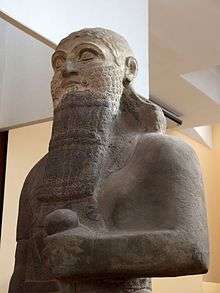 |
Shalmaneser III Šulmanu-ašaridu |
859 BC–824 BC (35 years) |
Son of Ashurnasirpal II | The long reign of Shalmaneser III was a constant series of campaigns against the eastern tribes, the Babylonians, the nations of Mesopotamia and Syria, as well as Kizzuwadna and Urartu. His armies penetrated to Lake Van and the Taurus Mountains; the Hittites of Carchemish were compelled to pay tribute, and the kingdoms of Hamath and Aram Damascus were subdued. | [3][50][51] |
| 106 | 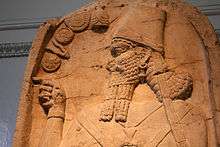 |
Shamshi-Adad V Šam-ši-Adad |
824 BC–811 BC (13 years) |
Son of Shalmaneser III | Shamshi-Adad V's ascension to the throne was contested by his brother Assur-danin-pal who was defeated after four years of civil war. Later, Shamshi-Adad V campaigned in the south against Babylon. | [3][50][51] |
| 107 | 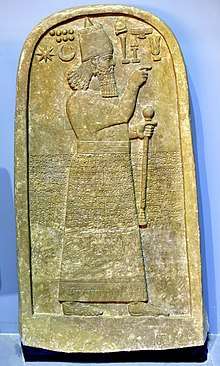 |
Adad-nirari III Adad-nārārī |
811 BC–783 BC (27 years) |
Son of Shamshi-Adad V | Came to the throne at a quite young age, leading his mother Shammuramat to act as regent for the first five years of his reign. Adad-nirari III led several military campaigns with the purpose of regaining the strength Assyria enjoyed in the times of his grandfather Shalmaneser III. | [3][50][51] |
| 108 | Shalmaneser IV Šulmanu-ašaridu |
783 BC–773 BC (11 years) |
Son of Adad-nirari III | Shalmaneser IV led several campaigns against Urartu. His rulership was severely limited by the growing influence of high dignitaries. | [3][50][51] | |
| 109 | Ashur-dan III Aššur-dān |
772 BC–755 BC (18 years) |
Brother of Shalmaneser IV, son of Adad-nirari III | Ashur-dan III's reign was difficult, with the growing influence of military officials, two plagues and a large revolt. | [3][50][51] | |
| 110 | Ashur-nirari V Aššur-nārāri |
755 BC–745 BC (11 years) |
Brother of Ashur-Dan III, son of Adad-nirari III | Due to difficulties at court, Ashur-nirari IV could not go on military campaigns for the first four years of his reign (it was customary for the king to campaign every year). He was eventually deposed and killed by Tiglath-Pileser III. | [3][50][51] |
Pre-Sargonid kings (745–722 BC)
The kings Tiglath-Pileser III and Shalmaneser V are sometimes referred to as the two "pre-Sargonid" kings since they might have been directly related to the Sargonids but predated the traditional founder of the Sargonid dynasty, Sargon II (722–705 BC).[52]
| No. | Image | King | Reign[27] | Succession | Notes | Ref |
|---|---|---|---|---|---|---|
| 111 | 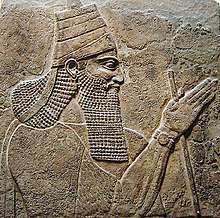 |
Tiglath-Pileser III Tukultī-apil-Ešarra |
745–727 BC (18 years) |
Usurper, claimed to be the son of Adad-nirari III | Originally a general by the name of Pulu, Tiglath-Pileser III seized the throne of Assyria in a bloody coup d'état in the midst of a civil war and slaughtered the royal family. Credited with introducing advanced civil, military, and political systems. Started the invasion of the Northern Kingdom of Israel. | [53][54] |
| 112 |  |
Shalmaneser V Šulmanu-ašaridu |
727–722 BC (5 years) |
Son of Tiglath-Pileser III | Continued the policies of Tiglath-Pileser III but was not as effective militarily, appears to have been a poor administrator who overtaxed the citizens of the empire. Probably assassinated in a coup d'état by his younger brother Sargon II, who took the throne. | [52] |
Sargonid dynasty (722–609 BC)
The Sargonid dynasty was founded by Sargon II when he usurped the throne from Shalmaneser V. It was the last ruling dynasty of the Neo-Assyrian Empire, ruling from 722 BC to the fall of the empire in 609 BC. The period is usually seen as the highest point of ancient Assyrian culture and the period in which the empire reached its maximum military power. Following the 631 BC death of Ashurbanipal, often seen as the last great Assyrian king, the empire swiftly collapsed until its conquest by the Median and Neo-Babylonian Empires.[52]
| No. | Image | King | Reign[27] | Succession | Notes | Ref |
|---|---|---|---|---|---|---|
| 113 | .jpg) |
Sargon II Šarru-kīn |
722–705 BC (17 years) |
Usurper, claimed to be the son of Tiglath-Pileser III | Usurping the throne from Shalmaneser V, Sargon II was a brilliant administrator and military leader who expanded the empire to its greatest extent yet. Sargon's successful campaigns saw the treasury of Assyria grow and he eventually founded a new capital, Dur-Sharrukin ("fortress of Sargon"). He was killed in battle by the Tabal people in Anatolia. | [52] |
| 114 | 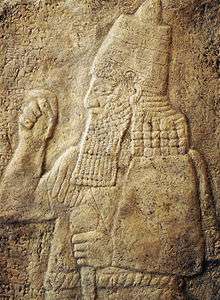 |
Sennacherib Sîn-ahhe-erība |
705–681 BC (24 years) |
Son of Sargon II | Sennacherib is most famous for conquering Israel, Judah and many Greek-speaking parts of Anatolia. Sennacherib moved the Assyrian capital to Nineveh, which he expanded with great gardens and architecture. Sennacherib plundered and desecrated Babylon, seen as great sacrilege, and was assassinated in a conspiracy by two of his sons. | [52] |
| 115 | 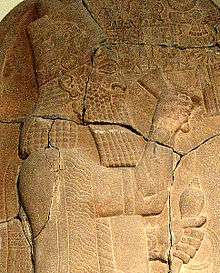 |
Esarhaddon Aššur-aḫa-iddina |
681–669 BC (12 years) |
Son of Sennacherib | Esarhaddon defeated his brother in a civil war and rebuilt Babylon, declaring that the previous destruction of the city was the will of the gods. Esarhaddon invaded Africa, conquering both Egypt and Kush. His reign saw advancement in medicine, literacy, mathematics, architecture and astronomy. | [52] |
| 116 | Ashurbanipal Aššur-bāni-apli |
669–631 BC (38 years) |
Son of Esarhaddon | Famous for the great library he collected at Nineveh, Ashurbanipal continued the policies of his father. He completed the subjugation of Egypt and defeated the Elamites. Often regarded as the last great Assyrian king. | [52] | |
| 117 | Ashur-etil-ilani Aššur-etel-ilāni |
631–627 BC (4 years) |
Son of Ashurbanipal | Little is known of the reign of Ashur-etil-ilani on account of the lack of surviving sources. As no records mention any military campaigns, it is often assumed that he was a weak ruler. | [52] | |
| 118 | 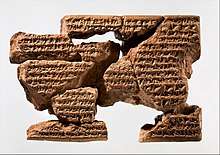 |
Sinsharishkun Sîn-šar-iškun |
627–612 BC (15 years) |
Son of Ashurbanipal | Sinsharishkun's reign saw the ultimate collapse of the Assyrian empire, repeatedly losing territory to a resurgent Babylon. in 612 BC, Nineveh was sacked, burned and razed by the coalition of enemies that had invaded during Ashur-etil-ilani's reign. The city was so thoroughly destroyed that within two generations, no one knew where it had lied. | [52] |
| – | 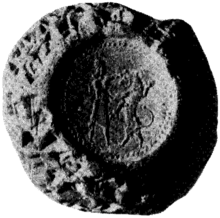 |
Sin-shumu-lishir Sîn-šumu-līšir |
626 BC (3 months) |
Usurper, general of Ashur-etil-ilani | Formerly the chief eunuch and a prominent official in Ashur-etil-ilani's reign. Rebelled against Sinsharishkun, successfully seizing cities in northern Babylonia, but defeated after three months. | [55] |
| 119 | Ashur-uballit II Aššur-uballiṭ |
612–609 BC (4 years) |
Unclear relation to the royal family, possibly the son of Sinsharishkun | Refusing the submit to the Neo-Babylonian empire, Ashur-uballit II rallied the remainder of the Assyrian army at the city of Harran, supported by Egypt. Harran was taken in 610 BC and Ashur-uballit defeated in 609 BC when he attempted to retake it. This marked the end of the Assyrian Empire. | [56][57] |
References
Citations
- Karlsson 2017, p. 2.
- Liverani 2013.
- Assyrian King List.
- Rowton 1970, pp. 194–195.
- La Boda 1994, p. 89.
- Azize 1998, p. 1–27.
- Meissner 1990, p. 101–102.
- Hagens 2005, p. 24.
- Hagens 2005, p. 27.
- Hallo 1980, p. 193.
- Stevens 2014, p. 73.
- Karlsson 2017, p. 1.
- Karlsson 2017, p. 12.
- Soares 2017, p. 21.
- Soares 2017, p. 28.
- Luckenbill 1927, p. 211.
- "Introducing the Assyrians". The British Museum Blog. 2018-06-19. Retrieved 2019-11-21.
- Melville, Sarah C. (2016). "The Role of Rituals in Warfare during the Neo-Assyrian Period". Religion Compass. 10 (9): 219–229. doi:10.1111/rec3.12206. ISSN 1749-8171.
- Parker, Bradley J. (2011). "The Construction and Performance of Kingship in the Neo-Assyrian Empire". Journal of Anthropological Research. 67 (3): 357–386. doi:10.3998/jar.0521004.0067.303. ISSN 0091-7710. JSTOR 41303323.
- Reade, Julian, Assyrian Sculpture, pp. 72-79, 1998 (2nd edn.), The British Museum Press, ISBN 9780714121413
- Roux 1994, p. 187.
- Rowton 1970, pp. 202–204.
- Glassner 2004, p. 137.
- Lewy 1966, p. 21.
- Dumbrill 2015, p. 97.
- "Ancient Egypt and Archaeology Web Site - Ancient Egypt - Assyrian". www.ancient-egypt.co.uk. Retrieved 2019-11-13.
- "The Assyrian King List - Livius". www.livius.org. Retrieved 2019-11-13.
- Roux 1994, p. 543.
- Lewy 1966, p. 746–747.
- Brinkman 2001, p. 63.
- Lewy 1966, p. 22.
- Glassner 2004, p. 136–144.
- Michel 2002, p. 17.
- Bertman 2005, p. 88.
- Leick 2001, p. 139.
- Leick 2001.
- Radner 2008, p. 371.
- Roux 1994, p. 123.
- Radner 1998, p. 179.
- Roux 1994.
- Veenhof 2008, p. 24.
- Grayson 1972, p. 30.
- Dalley 2009, p. 3.
- Leick 2001, p. 29.
- For variants, see footnotes 49–56 in Glassner, Jean-Jacques (2004). Mesopotamian Chronicles. Society of Biblical Literature. p. 155. ISBN 1589830903.
- Rowton 1970.
- Brinkman 1973.
- Grayson 1987.
- Newgrosh 1999.
- Wilkinson et al. 2005.
- Bedford 2001.
- Mark 2014.
- Tadmor 1994, p. 29.
- Frye, Wolfram & Dietz 2016.
- Na’aman 1991, p. 256.
- Fall of Nineveh.
- "Royal marriage alliances and noble hostages". www.ucl.ac.uk. Retrieved 2019-11-20.
Cited bibliography
- Azize, Joseph (1998). "Who was responsible for the Assyrian King List?". Abr-Nahrain. 35: 1–27.
- Bedford, P. (2001). Empires and Exploitation: The Neo-Assyrian Empire (PDF). WA Perth. Archived from the original (PDF) on 2008-08-27.
- Bertman, Stephen (2005). Handbook to Life in Ancient Mesopotamia. Oxford University Press.
- Brinkman, J. A. (1973). Comments on the Nassouhi Kinglist and the Assyrian Kinglist Tradition. Orientalia N.S 42.
- Brinkman, J. A. (2001). "Assyria". The Oxford companion to the Bible. Oxford University Press.
- Dalley, Stephanie (2009). Babylonian Tablets from the First Sealand Dynasty in the Schoyen Collection. CDL Press.
- Dumbrill, Richard (2015). Musical Scenes and Instruments on seals, sealings and impressions from the Ancient Near East. Lulu. ISBN 9781326289324.
- Glassner, Jean-Jacques (2004). Mesopotamian Chronicles. Society of Biblical Literature. ISBN 978-1589830905.
- Grayson, A. K. (1972). Assyrian Royal Inscriptions, Volume 1. Otto Harrassowitz.
- Grayson, A. K. (1987). Assyrian Rulers of the Third and Second Millennia BC. University of Toronto Press. ISBN 978-0-8020-2605-7.
- Frye, Richard N.; Wolfram, Th. von Soden; Dietz, O. Edzard (15 April 2016). "History of Mesopotamia". Encyclopædia Britannica.CS1 maint: ref=harv (link)
- Hagens, Graham (2005). "The Assyrian King List and Chronology: a Critique". Orientalia. 74 (1): 23–41. JSTOR 43076931.
- Hallo, William W. (1980). "Royal Titles from the Mesopotamian Periphery". Anatolian Studies. 30: 189–195. doi:10.2307/3642789. JSTOR 3642789.
- Karlsson, Mattias (2017). "Assyrian Royal Titulary in Babylonia". Cite journal requires
|journal=(help) - La Boda, Sharon (1994). International Dictionary of Historic Places: Middle East and Africa. Taylor & Francis. ISBN 978-1884964039.
- Leick, Gwendolyn (2001). Who's Who in the Ancient Near East. Routledge. ISBN 978-0-415-13231-2.
- Lewy, Hildegard (1966). The Cambridge Ancient History: Assyria c. 2600-1816 B.C.
- Liverani, Mario (2013). The Ancient Near East: History, Society and Economy. Routledge. ISBN 978-0415679060.
- Luckenbill, Daniel David (1927). Ancient Records of Assyria and Babylonia Volume 2: Historical Records of Assyria From Sargon to the End. University of Chicago Press.
- Meissner, Bruno (1990). Reallexikon der Assyriologie. Walter de Gruyter. ISBN 978-3110100518.
- Michel, C. (2002). Nouvelles données pour la chronologie du IIe millénaire. NABU 2002, Nr. 20.CS1 maint: location (link)
- Na’aman, Nadav (1991). "Chronology and History in the Late Assyrian Empire (631—619 B.C.)". Zeitschrift für Assyriologie. 81: 243–267.
- Newgrosh, B. (1999). "The Chronology of Ancient Assyria Re-assessed". Journal of the Ancient Chronology Forum. 8: 78–106.
- Radner, Karen (1998). The Prosopography of the Neo-Assyrian Empire, Volume 1, Part I: A. The Neo-Assyrian Text Corpus Project.
- Radner, Karen (2008). Reallexikon der Assyriologie und Vorderasiatischen Archäologie 11: Prinz, Prinzessin - Samug. Walter de Gruyter.
- Radner, Karen (2010). "The stele of Sargon II of Assyria at Kition: A focus for an emerging Cypriot identity?" (PDF). Interkulturalität in der Alten Welt: Vorderasien, Hellas, Ägypten und die vielfältigen Ebenen des Kontakts. Harrassowitz Verlag. ISBN 978-3447061711.
- Roux, Georges (1992). Ancient Iraq. Penguin Books Limited. ISBN 9780140125238.
- Rowton, M. B. (1970). The Cambridge Ancient History. Cambridge University Press. ISBN 978-0521070515.
- Soares, Filipe (2017). "The titles 'King of Sumer and Akkad' and 'King of Karduniaš', and the Assyro-Babylonian relationship during the Sargonid Period" (PDF). Rosetta. 19: 20–35.
- Stevens, Kahtryn (2014). "The Antiochus Cylinder, Babylonian Scholarship and Seleucid Imperial Ideology" (PDF). The Journal of Hellenic Studies. 134: 66–88. doi:10.1017/S0075426914000068. JSTOR 43286072.
- Tadmor, Hayim (1994). The Inscriptions of Tiglath-Pileser III, King of Assyria: Critical Edition, with Introductions, Translations, and Commentary. Jerusalem: Israel Academy of Sciences and Humanities.CS1 maint: ref=harv (link)
- Wilkinson, T. J.; Wilkinson, E. B.; Ur, J.; Altaweel, M. (2005). "Landscape and Settlement in the Neo-Assyrian Empire". Bulletin of the American Schools of Oriental Research.
Cited web sources
- "The Assyrian King List - Livius". www.livius.org. Retrieved 2 April 2019.
- "The fall of Nineveh, capital of the Assyrian Empire - British Museum". www.britishmuseum.org. Archived from the original on 2015-10-17. Retrieved 17 October 2015.
- Joshua J., Mark. "Sargonid Dynasty - Ancient History Encyclopedia". www.ancient.eu. Retrieved 2 April 2019.
